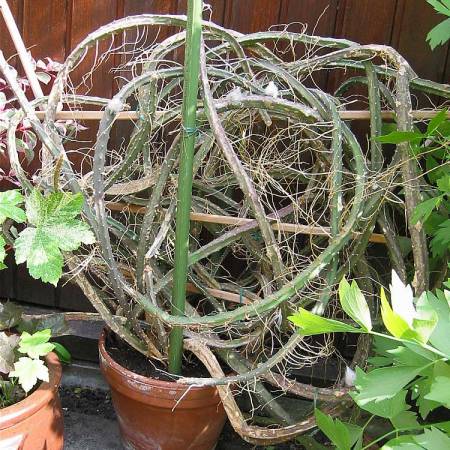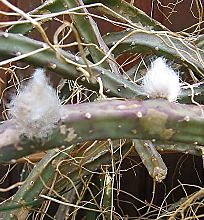 Koningin van de Nacht - Selenicereus grandiflorus (Cactaceae)
Koningin van de Nacht - Selenicereus grandiflorus (Cactaceae)

Mijn Selenicereus grandiflorus op 30 mei 2003 - de witte punten zijn knoppen
 Koningin van de Nacht - Selenicereus grandiflorus (Cactaceae)
Koningin van de Nacht - Selenicereus grandiflorus (Cactaceae)

Rond 30 mei 2003 ontdekte ik ineens weer van die witte harige puntjes (bloemknoppen!) op de "ouwe fiets", zoals ik de plant na de mislukte bloei van 2002 had genoemd. Ik voelde me schuldig omdat ik plantlief nog nooit had durven verpotten, en besloot het avontuur nu toch maar aan te gaan - ik sleepte 'm naar buiten (het was eindelijk mooi weer sinds 25 mei, we hadden een verschrikkelijke meimaand), legde hem plat op zijn zij, keek 'm zo goed mogelijk na op de witte dotjes van de wolluis, en gaf 'm nieuwe grond en een iets grotere pot. Het viel me mee, dat ik dat voor mekaar kreeg zonder problemen.
Met tuinhandschoenen aan had ik me niet bezeerd aan de stekelige stengels.
Een vriendin van me (die me ooit die witte Epiphyllum had gegeven, en er zelf nog steeds eentje heeft) vond 't maar griezelig dat ik de plant had verpot terwijl hij al knoppen had gevormd. Ik zei, dat ze er zeker weer af zouden zijn gevallen als ik 'm niet had verpot, en er nu misschien een kans was dat er iets van terechtkwam.
Eenmaal verpot, bleef de plant nog een weekje buiten staan - om weer even schoon te regenen, het stof eraf. Natuurlijk viel er ook water in de pot. Nadat ik 'm weer binnen had gehaald, gaf ik 'm meer water dan voorheen, want ik zag dat de roesterige stengels niet alleen groener, maar ook steviger en ronder waren geworden - alsof de platte banden van de "oude fiets" waren opgepompt!
Ik had altijd maar het idee gehad, dat de plant bijna geen water mocht hebben, maar als hij bloemen moest vormen had hij daar natuurlijk ook vocht voor nodig!
De knoppen groeiden uit tot een soort vogelkoppen, ze leken wel wat op gierenkoppen vond ik.
Op een mooie dag (26 juni) besloot ik ze eens na te kijken op wolluizen. En ja, onder de haren en de opgevouwen kelkblaadjes zaten er inderdaad wel enige tientallen. Allemaal een ruggeprik gegeven met een satéprikker, voor zover ik ze kon vinden.

En toen - tot m'n grote verrassing! Op 27 juni lieten de kelkblaadjes van één knop ineens wat los, en kwam de witte kroon ertussenuit kijken - die avond ontvouwde zich de eerste bloem.Success at last with my own plant in 2003!
Schitterend, eindelijk succes! Hij was trouwens iets kleiner dan ik had verwacht, want er wordt altijd gezegd dat ze een diameter van 30 cm hebben terwijl deze 21 cm was - niks groter dan de witbloeiende bladcactus Epiphyllum crenatum, die bovendien 2 nachten bloeit i.p.v. één.
De volgende morgen, 28 juni, was de bloem uitgebloeid, maar twee andere knoppen sprongen los - en bloeiden dus 's avonds. De bovenste, die vlak naast de uitgebloeide aan de stengel zat, mat 23 cm, en de onderste en mooiste was 27 cm, dus behoorlijk groot! Ik heb ze tot een uur of 3 's nachts bewonderd en rond half drie de laatste foto genomen.
Ik had een beetje een liefde-haatverhouding met de plant, maar door dit succes was hij behoorlijk in mijn achting gestegen...
Op bovenstaande foto kijk je tussen de bruine kelk- en de witte kroonbladen in een gele zone. Volgens mij komt daar de (niet al te sterke) geur van de bloem vandaan, en niet uit het midden!
Overigens vind ik dat deze bloem lang zo'n sterke en lekkere lucht niet heeft als de Epiphyllum die ik eerst als Koningin van de Nacht op m'n website had staan. Die ruikt nl. naar citroen of citronella, terwijl de echte Koningin een wat ondefinieerbare geur heeft die in een boek als "vanille-achtig" werd beschreven, maar volgens mij nog eerder een beetje naar chocolade (cacaopoeder) ruikt, zoals wordt gemeld op de Duitstalige Zwitserse website waarnaar ik ook een link op m'n selenicereusmail-pagina heb staan: zie fotoserie en Duitse tekst.
Hierboven de achterkant van de bloem, met mijn hand erbij, zodat het formaat ook enigszins te schatten valt. De bloembuis is heel lang en stekelig, en het vruchtbeginsel is nog veel dichter bezet met stekels, zoals op de foto wel is te zien.
In totaal waren er 5 knoppen, die ook alle zijn uitgekomen.
De eerste op 27 juni, toen twee tegelijk op 28 juni, één op 4 juli en de laatste op 19 juli 2003.
En daarna stond de plant weer kaal in huis - tot de kerstdagen kwamen...
Tenslotte nog een paar scans van een afgevallen bloem en een doorgesneden vruchtbeginsel.

 Queen of the Night - Selenicereus grandiflorus (Cactaceae)
Queen of the Night - Selenicereus grandiflorus (Cactaceae)

Around 30 May 2003 I suddenly again discovered a few of those hairy white tufts (flower buds!) on the "old bicycle", as I had called the plant after the failed bloom of 2002. I felt guilty because I had never found the courage to repot my precious plant, but decided to risk it now - I carried it outside (since 25 May the weather had been fine at last, we'd had a terrible month of May), laid it flat on its side, and had a proper look if there were any white spots with waxy aphids, and gave it new soil and a slightly bigger pot. I was surprised to achieve this without any problems.
With garden-gloves on my hands I hadn't got hurt by the prickly stems.
A friend of mine (who once gave me that white Epiphyllum, and still has one herself) thought it a great risk to repot the plant while it already had formed buds. I said not-repotting would have given certainty of bud-loss again, while now I had a bit of chance at least something might come of it.
Once repotted, the plant stayed outside for a week - to get some rain on it to remove the dust. Of course some rainwater fell on the soil too. After bringing the plant inside again, I gave it more water than before, because I saw the rusty stems hadn't only become greener, but also sturdier and rounder - as if the flat tyres of my "old bicycle" had been pumped up!
I'd always had the idea that the plant hardly needed any water, but if it had to form flowers some moisture would be required!
The buds grew into a kind of birds' heads, they were a bit like vultures' heads I thought.
On a beautiful day (26 June) I decided to check for waxy aphids again. And yes, among the hair and the folded sepals there were a few dozens of them. I gave them all a spinal puncture with a satay stick, as far as I could find them.

And then - to my great surprise! On 27 June the sepals of one bud suddenly came a little apart, showing tips of the white corolla - that evening the first flower unfolded.
Magnificent, success at last! However, it was a bit smaller than I would have expected, for it's said they have a diameter of about 30 cm while this flower was only 21 cm - not bigger than the white-flowering Epiphyllum crenatum, which flowers even 2 nights and a day instead of only one night.
The next morning, 28 June, it was past flowering, but two other buds started to unfold - and were in bloom that evening. The uppermost flower, right beside the faded one on the same stem, was 23 cm, and the undermost and best one 27 cm, really big! Around 2.30 a.m. I took the last picture, and sat admiring the flowers till about 3 o'clock in the morning.
I used to have a sort of love-hate relationship with the plant, but at this success surely it had gone up in my estimation...
In the photo above you look between the brown sepals and the white petals in a yellow zone. I think it's there the (not very strong) fragrance of the flower comes from, and not from the centre!
I must say these flowers don't have such a strong and pleasant smell as those of the Epiphyllum I first thought to be the Queen of the Night. That one smells of lemon or citronella, while the real Queen gives off an undefined smell which was described in a book as "vanilla-like", but in my experience has more resemblance to cocoa powder, as is referred to on a Swiss website in German language to which I linked on my selenicereusmail-page: see photo series and German text.
Above the back of the flower, with my hand, so you can get an idea of the size.
The flowertube is very long and prickly, and the ovary even more spiny as you can see in the picture.
There were 5 buds, and all came into flower.
The first on 27 June, then two at once on 28 June, one on 4 July and the last one on 19 July 2003.
And afterwards the plant was just dull and green again - until Christmas came...
Finally, a few scans of a dropped-off flower and a vertical section of an ovary.

